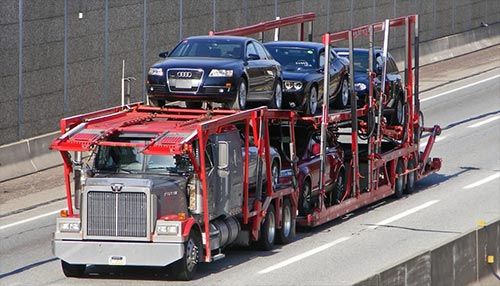Are you ready to take your business to new heights? Whether you’re a construction company expanding into global markets or an equipment dealer looking to tap into international demand, heavy equipment international shipping is the key to unlocking endless opportunities. But how exactly do you transport massive machines like excavators across oceans and continents? Fear not, because in this comprehensive guide, we will demystify the process and provide you with invaluable insights on how to streamline your business operations. So fasten your seatbelts (or should we say secure those cargo straps?), as we embark on a journey through the world of heavy equipment shipping!
How are excavators shipped overseas?
Excavators, those mighty machines that can dig through mountains and move tons of earth, may seem immovable on the job site. But what happens when you need to ship them overseas? Well, rest assured, there are efficient and reliable methods in place to get these heavy-duty beasts from one continent to another.
One common way to transport excavators internationally is by container shipping. This method involves disassembling the excavator into smaller components and securing them inside a shipping container. By doing so, not only does it allow for easier handling and loading onto cargo ships, but it also provides protection against potential damage during transit.
For larger excavators that cannot fit inside standard containers, roll-on roll-off (Ro-Ro) shipping is often used. With Ro-Ro shipping, the machine is driven or rolled onto a specialized vessel using ramps or hydraulic platforms. This method eliminates the need for disassembly and ensures a more streamlined process.
In some cases where distance becomes an obstacle, flat rack shipping comes into play. Flat racks are essentially open-sided containers with no roof or walls, allowing for oversized equipment like long reach excavators to be securely loaded onto them sideways before being shipped overseas.
Transporting such massive machinery requires meticulous planning and expertise. It is important to work with reputable logistics companies experienced in heavy equipment international shipping, who understand the intricacies involved in ensuring safe transportation from origin to destination.
So, next time you see an excavator effortlessly digging up dirt at your local construction site, remember that behind its impressive presence lies a well-coordinated logistical dance orchestrated by professionals in heavy equipment international shipping!
How can I ship large equipment?
Shipping large equipment can be a complex process, but with the right planning and preparation, you can ensure a smooth and successful delivery. Here are some steps to help you ship your large equipment internationally.
It is important to determine the dimensions and weight of your equipment accurately. This will help you choose the appropriate shipping method and container size. You may need to dismantle certain parts of the equipment or secure them properly for transportation.
Next, research and select a reputable freight forwarder that specializes in heavy equipment international shipping. They will handle all aspects of logistics, including documentation, customs clearance, and transportation arrangements.
Depending on the destination country and available infrastructure, your equipment may be shipped via ocean freight or air cargo. Ocean freight is typically more cost-effective for larger items but takes longer than air cargo.
Proper packaging is crucial for protecting your large equipment during transit. Use sturdy crates or containers specifically designed for heavy machinery. Secure any loose parts or accessories properly to prevent damage during handling.
When loading and unloading your equipment onto trucks or vessels, specialized lifting tools such as cranes or forklifts may be required. It is essential to work with experienced professionals who have expertise in safely handling heavy loads.
Make sure you have adequate insurance coverage for your equipment during transit, as accidents can happen despite careful planning and precautions.
By following these guidelines and partnering with trusted experts in heavy equipment shipping services, you can efficiently streamline the process of transporting your large machinery overseas.
How are huge excavators transported?
Transporting huge excavators is no easy feat. These heavy pieces of machinery require specialized equipment and careful planning to ensure safe and efficient delivery. So, how exactly do they transport these massive machines?
It’s important to note that the transportation method will depend on various factors such as the size and weight of the excavator, as well as the distance it needs to be transported. In some cases, flatbed trucks or lowboy trailers may be used. These trailers are specially designed to handle heavy loads and can accommodate oversized equipment.
Once loaded onto the trailer, securing the excavator becomes crucial. Heavy-duty straps and chains are used to keep it in place during transit. Additionally, padding or cushioning materials may be utilized to protect sensitive components from any potential damage.
In some instances, where regular road transportation is not feasible due to size restrictions or remote locations, alternative methods like rail or barge transport may be employed. Rail transport involves loading the excavator onto a specialized railcar using cranes or ramps. Barge transport entails floating the machine on a water vessel equipped with appropriate lifting mechanisms.
Transporting huge excavators requires meticulous planning and execution using specialized equipment tailored for oversized loads. It is an intricate process that demands expertise in logistics management and adherence to safety regulations, ensuring your heavy machinery reaches its destination intact and ready for action!
How do you transport a long reach excavator?
Transporting a long reach excavator can be a complex task due to its size and weight. However, with the right planning and expertise, it is possible to streamline this process just like any other heavy equipment international shipping.
To transport a long reach excavator, specialized equipment and vehicles are required. This includes low-bed trailers or flatbeds that can accommodate the length of the machine. Additionally, additional support may be needed in terms of cranes or forklifts to load and unload the excavator onto the trailer.
It is crucial to ensure that proper securing measures are taken during transportation to prevent any damage or accidents. This may involve using chains, straps, or other securement devices to keep the excavator in place throughout the journey.
Moreover, obtaining appropriate permits and adhering to all legal regulations is essential when transporting oversized equipment like long reach excavators across international borders. Working with an experienced freight forwarder who specializes in heavy equipment shipping can greatly simplify this process by handling all necessary paperwork and ensuring compliance with customs requirements.
In conclusion, streamlining your business with heavy equipment international shipping requires careful planning and coordination at every step of the process. From understanding how various types of heavy machinery are shipped overseas to choosing suitable transport methods for large equipment, there is much involved in ensuring a smooth operation.
By partnering with reputable freight forwarding companies that specialize in heavy equipment transportation, you can leverage their knowledge and expertise while focusing on your core business activities. With comprehensive guidance provided by professionals who understand the intricacies of international shipping for heavy machinery, you can navigate through logistical challenges effectively and efficiently.
So, whether you need to ship an excavator abroad or transport any other type of heavy machinery internationally, following these guidelines will help streamline your operations while ensuring safe delivery every time!
Pros:
– Cost savings due to reduced fuel costs and insurance coverage
– Ability to ship large and bulky items quickly and efficiently
– Increased security while shipping
– Access to international markets
– Ability to transport large amounts of goods in a single shipment
Cons:
– High cost of international shipping
– Delays in delivery due to customs or other international regulations
– Risk of damage to goods due to rough handling during shipping
– Difficulty in tracking shipments while in transit
– Difficulty in managing all the paperwork associated with international shipping
FAQs:
1. What paperwork do I need to ship heavy equipment internationally?
Answer: You will need to provide documentation such as a bill of lading, proof of purchase, export declaration forms, and other documents in order to successfully ship your heavy equipment internationally.
2. How long does it take for international heavy equipment shipping?
Answer: The exact time frame will depend on the type of cargo, the country of origin and destination, and the mode of transportation. Generally, however, international heavy equipment shipping can take anywhere from several days to several weeks.
3. Are there any special regulations or restrictions when shipping heavy equipment internationally?
Answer: Yes, different countries have their own specific regulations and restrictions when it comes to shipping heavy equipment internationally. It is important to research these regulations and restrictions before shipping your equipment.
4. What types of carriers are available for international heavy equipment shipping?
Answer: Common carriers used for international heavy equipment shipping include air freight, land freight, sea freight, and rail freight.
5. How much does international heavy equipment shipping cost?
Answer: The cost of international heavy equipment shipping will vary depending on the size and weight of your equipment, the country of origin and destination, and the mode of transportation.
Features:
1. Professional heavy equipment shipping services: We provide reliable and experienced services to ship heavy equipment internationally.
2. Competitive prices: Our experienced team will ensure that you get the best possible price for shipping your heavy equipment.
3. Fast and secure delivery: We use the latest technology and secure methods of shipment to ensure your equipment arrives safely and quickly.
4. Experienced staff: Our experienced staff are trained to handle all sorts of heavy equipment and can provide expert advice and assistance.
5. Comprehensive insurance coverage: We provide comprehensive insurance coverage to protect your equipment during transit.
6. Global network: We have a global network of trusted partners to make sure your equipment is delivered safely and on time.
7. Door-to-door delivery: We offer door-to-door delivery services to make sure your equipment arrives at its destination on time and in perfect condition.
8. Documentation assistance: We provide expert assistance with preparing the necessary documents for international shipment.
9. Customized solutions: Our team can provide customized solutions to meet your individual needs and requirements.
10. Flexible payment options: We offer flexible payment options to make sure you can pay for your shipment conveniently.

